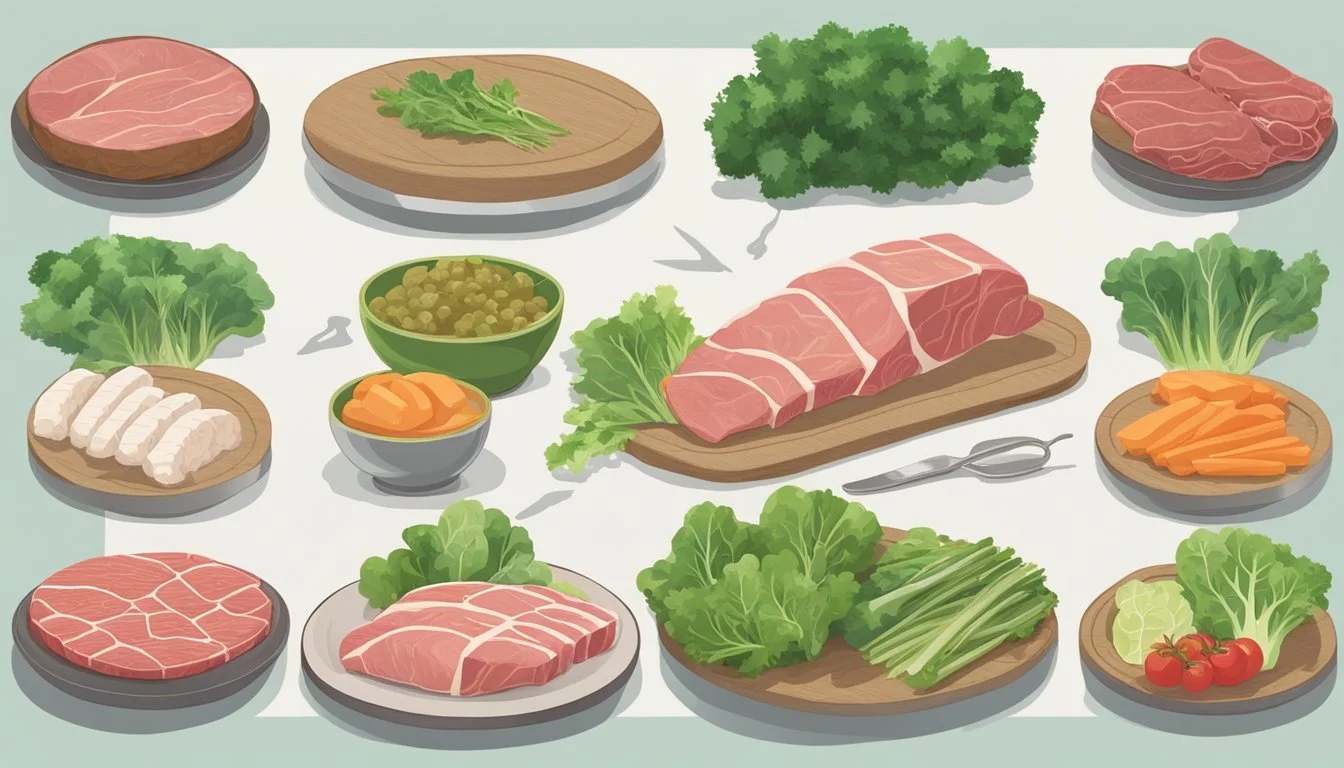Carnivore Diet vs. The Sirtfood Diet
Unraveling the Impact on Metabolic Health
The Carnivore Diet and the Sirtfood Diet represent two distinct approaches to health and weight loss, each tapping into different biological mechanisms. The Carnivore Diet is characterized by a regimen consisting exclusively of animal products—meat, fish, eggs, and certain dairy products. Proponents of this diet argue that it aligns with an evolutionary perspective, suggesting a high intake of protein and fat can lead to weight loss and improved health markers.
In contrast, the Sirtfood Diet focuses on activating "skinny genes," or sirtuins, which are proteins that regulate cellular health and metabolism. This diet includes a variety of polyphenol-rich foods—such as kale, red wine, and dark chocolate—that are believed to stimulate these genes. The diet is structured to mimic the effects of calorie restriction without an actual significant reduction in calorie intake, potentially offering a way to achieve some of the benefits associated with fasting.
Both diets garner interest for their potential to not just influence weight, but also to impact overall metabolic health through very different avenues: one through a zero-carb, high-animal-product intake, and the other through nutrient-rich plant-based foods and the moderation of calorie intake. Despite their popularity, both remain controversial and are subject to ongoing research and debate within the nutrition community.
Exploring the Carnivore Diet
The Carnivore Diet emphasizes animal products and excludes plant-based foods, focusing on protein and fat while minimizing carbohydrate intake.
Principles and Foods Included
The core principle of the Carnivore Diet is to consume primarily animal-based foods such as:
Meat: Beef, pork, lamb, and game meat
Poultry: Chicken and turkey
Fish: Salmon, trout, and other fish varieties
Eggs and Dairy: Chicken eggs and dairy products for those who tolerate them
Organ Meats: Liver and other organ meats as nutrient-dense options
Unlike mixed diets, it excludes all plant-based foods, which means no fruits, vegetables, grains, legumes, nuts, seeds, or fiber sources.
Potential Benefits and Risks
Potential benefits include:
Simplified meal planning
High satiety from protein and fat intake
However, there are significant risks to consider:
Nutrient Deficiencies: A lack of diverse vitamins and minerals typically found in plant foods
Chronic Disease: Potential increased risk due to high intake of saturated fats
Lack of Fiber: May lead to digestive issues since fiber is absent from the diet
Carnivore Diet and Weight Loss
For individuals seeking weight loss, the Carnivore Diet can:
Lead to a reduction in appetite due to high protein and fat content
Cause a metabolic shift that may facilitate fat burning
However, long-term effects on weight loss and overall health are not well-documented, and the diet's restrictive nature may lead to potential nutrient deficiencies, particularly if organ meats like liver—which contain essential nutrients—are not regularly consumed.
Understanding the Sirtfood Diet
The Sirtfood Diet is gaining popularity for its unique focus on foods that are said to activate sirtuins, a group of proteins associated with weight loss and metabolic benefits. This diet has been popularized by celebrities and is characterized by its inclusion of "sirtfoods" and structured phases that aim for rapid weight loss.
Key Components and Sirtuin-Activating Foods
The cornerstone of the Sirtfood Diet revolves around sirtuins, a family of proteins that research suggests may regulate metabolism and inflammation, and potentially influence the body’s ability to burn fat. These proteins are activated by a group of plant-based compounds known as polyphenols. Sirtfoods, rich in polyphenols, include:
Kale: A nutrient-dense leafy green.
Berries: Such as blueberries and strawberries, known for their antioxidant properties.
Olive Oil: A heart-healthy fat that is a staple in Mediterranean diets.
Green Juice: Typically made from kale, celery, parsley, green tea, and lemon, adhering to the diet's guidelines.
Weight Loss and Calorie Restriction
Calorie restriction plays a significant role in the Sirtfood Diet, as it is believed to mimic the effects of fasting and exercise by activating sirtuins. This aspect of the diet claims to help shed pounds quickly, a benefit that has contributed to its attraction among public figures like Adele and Pippa Middleton. However, it's crucial to approach calorie restriction with caution to ensure nutritional needs are met.
Phases of the Sirtfood Diet
The Sirtfood Diet is structured into two distinct phases:
Phase 1: Lasting seven days, this phase combines calorie restriction (limiting intake to 1000 calories per day for the first three days) with a high intake of sirtfoods, primarily through green juices and one meal. For the final four days, calorie intake is increased to 1500 calories, consisting of two green juices and two meals.
Phase 2: Spanning fourteen days, this maintenance phase has no strict calorie limit but encourages three balanced sirtfood-rich meals and one green juice daily.
Adherence to these phases is intended to result in weight loss while also incorporating nutritious sirtfoods into one's diet.
The Role of 'Skinny Genes'
Understanding 'skinny genes' involves an exploration of how genetic factors can influence metabolism and weight loss, and the specific role played by sirtuins as regulators within this process.
Genetic Influence on Metabolism and Weight Loss
It is well-documented that genetics play a crucial role in determining an individual's metabolism speed and efficiency, which in turn affects weight loss capabilities. Distinct genetic profiles can explain variations in how people respond to diet and exercise, with some individuals possessing genetic variants that make weight management more challenging.
Sirtuins and Their Impact on Health
Sirtuins, a group of proteins that the term 'skinny genes' often refers to, are pivotal in the regulation of metabolic processes related to aging and health benefits. These sirtuin proteins are involved in critical cellular functions, including DNA repair and inflammation reduction. They are believed to have anti-aging properties and play a role in extending cell life, which could contribute to improved metabolism and weight loss. The Sirtfood Diet is designed to activate these proteins, suggesting potential health advantages beyond just weight management.
Comparing Dietary Outcomes and Research
In examining the outcomes of the Carnivore diet versus the Sirtfood diet, research indicates varied impacts on muscle mass and metabolic rate, inflammation, and aging. Long-term human studies offer essential insights into the sustainability and effectiveness of these diets.
Impact on Muscle Mass and Metabolic Rate
Muscle Mass: Studies suggest that the high protein intake of the Carnivore diet may be beneficial for increasing muscle mass, given adequate exercise. Conversely, the Sirtfood diet, while rich in nutrients, may not inherently promote muscle growth unless combined with protein supplementation.
Carnivore Diet: Likely positive impact on muscle mass when paired with resistance training.
Sirtfood Diet: Needs careful planning to ensure muscle growth due to lower protein focus.
Metabolic Rate: Both diets have the potential to influence metabolic rate due to their macronutrient composition.
Carnivore diet: High in protein, which can increase thermogenesis and, consequently, metabolic rate.
Sirtfood diet: Incorporates foods that activate 'sirtuins,' proteins that research indicates may improve metabolism.
Effects on Inflammation and Aging
Inflammation: Dietary choices greatly affect bodily inflammation levels, a key variable in chronic disease and aging.
Carnivore Diet: Eliminates many food sources known to cause inflammation, but long-term effects on inflammation markers are not well documented.
Sirtfood Diet: Emphasizes anti-inflammatory foods, potentially reducing inflammation and supporting anti-aging processes.
Aging: Aging is influenced by genetic and environmental factors, with diet playing a crucial role.
Sirtfood Diet: Hailed for its engagement with "skinny genes," or sirtuins, which may mimic the aging-slowing effects of caloric restriction.
Carnivore Diet: Research is less definitive, lacking in evidence of anti-aging effects.
Evidence from Long-Term Human Studies
Long-term studies in humans regarding the Carnivore and Sirtfood diets are scarce, given their emergence into popularity relatively recently. Most current evidence is derived from short-term research or anecdotal reports.
Carnivore Diet: Few long-term human studies exist, and those that do predominantly analyze the health impacts of meat consumption, not the diet in its entirety.
Sirtfood Diet: Also lacks extensive long-term human studies; current research is largely based on the effects of resveratrol and other sirtuin-activating compounds tested on animals, such as mice, and to a lesser extent, humans.
Nutritional Considerations and Whole Foods
When assessing diets such as the Carnivore Diet and the Sirtfood Diet, it is crucial to understand how they incorporate or exclude essential nutrients, vitamins, minerals, and dietary fiber. Whole foods, including fruits, vegetables, and grains, play a significant role in delivering these necessary dietary components.
Importance of Vitamins, Minerals, and Fiber
Vitamins and minerals are essential for maintaining bodily functions and preventing diseases. The Carnivore Diet, which prioritizes animal products, may provide substantial amounts of vitamins B12 and D, zinc, and iron, which are crucial for nerve function, immune health, and oxygen transportation. However, its exclusion of plant-based foods could lead to deficiencies in vitamin C, various B-vitamins, and antioxidants that are predominantly found in fruits and vegetables.
Fiber, another crucial component, is absent in animal products. Dietary fiber, found in fruits, vegetables, and whole grains, aids in digestion, helps maintain blood sugar levels, and supports heart health. Diets lacking in fiber may lead to gastrointestinal issues and could impact cardiovascular health.
Sources of Fiber: Fruits, vegetables, whole grains, legumes, nuts, and seeds.
Key Animal-Based Nutrients: Vitamins B12 and D, zinc, iron, and omega-3 fatty acids.
Key Plant-Based Nutrients: Vitamins C, K, folate, magnesium, and flavonoids.
Inclusion of Fruits, Vegetables, and Whole Grains
The Sirtfood Diet, in contrast, emphasizes the inclusion of plant-based foods that activate the so-called "skinny genes" due to their high content of specific compounds such as polyphenols. Fruits and vegetables are loaded with vitamins and minerals that are essential for overall health and help to reduce inflammation and oxidative stress.
Whole grains provide not only fiber but also a variety of essential nutrients including B-vitamins, which play a key role in energy metabolism, and minerals such as magnesium, which is vital for muscle and nerve function.
Examples of Sirtfoods: Kale, strawberries, onions, soy, parsley, extra virgin olive oil, and walnuts.
Whole Grain Benefits: Supply dietary fiber, B-vitamins, antioxidants, and trace minerals.
Consumption of a wide variety of plant-based whole foods is associated with a lower risk of chronic diseases and supports long-term health and well-being.
Health Perspectives and Dietician Recommendations
In examining the Carnivore and Sirtfood diets, dietitians weigh in on potential health benefits and risks, with a keen focus on how these diets interact with 'skinny genes' and overall wellness.
Addressing Potential Health Benefits
Carnivore Diet:
Health Benefits: Advocates suggest it may decrease inflammation and simplify dietary choices, potentially benefiting those with autoimmune diseases.
Blood Pressure: An all-meat diet could lead to changes in blood pressure due to reduced carbohydrate intake.
Sirtfood Diet:
Health Benefits: Known for promoting foods that activate sirtuins, proteins linked to anti-aging and metabolism, this diet may support metabolic health.
Caloric Restriction: Integrates moderate caloric restriction, which might aid in weight loss and longevity.
Understanding the Risks and Possible Side Effects
Carnivore Diet:
Risks: Diets high in meat potentially increase the risk of heart disease and may not provide a full spectrum of nutrients. There is also a concern for higher cholesterol levels.
Disordered Eating: A strict, all-meat regimen can be restrictive and may contribute to disordered eating patterns.
Sirtfood Diet:
Risks: As a newer diet, long-term effects are not well-studied; rapid weight loss phases may not be sustainable or healthy for all individuals.
Fad Diet: Some dietitians are cautious, labeling it as a fad diet due to trendy, stringent protocols which may not be backed by strong scientific evidence.
Dietitians generally recommend diverse diets that meet all nutritional needs and encourage consulting a healthcare professional before starting any new diet, particularly those that are highly restrictive or significantly different from standard dietary patterns.
Lifestyle Considerations and Sustainability
When assessing diets like the Carnivore and Sirtfood diets, long-term maintenance and integration of exercise are crucial to evaluate. Both diets demand significant shifts in eating habits, which can have implications for sustainability and lifestyle fit.
Maintaining Diets in the Long Term
The Carnivore Diet consists entirely of animal products and excludes other food groups. Its high-protein focus is simple but may be challenging to sustain due to limited variety and potential nutrient deficiencies. On the other hand, the Sirtfood Diet promotes the inclusion of plant-based 'sirtfoods' known for activating 'skinny genes'. However, it's complex and requires following multiple phases, which may hinder long-term adherence.
Key considerations for maintenance include:
Nutrient variety: Ensuring a comprehensive intake of nutrients can be challenging on a restrictive eating plan.
Palatability: Enjoyment of the diet affects long-term adherence.
Cost: The expense of specific foods, like high-quality meat or specialty 'sirtfoods', can impact sustainability.
Incorporating Exercise and Lifestyle Habits
Exercise plays a significant role in overall health and may enhance the benefits of any diet. The incorporation of physical activity can be an essential factor in the potential lifespan of adherence to a diet.
For the Carnivore Diet:
High-intensity and resistance training may complement the high intake of protein, aiding in muscle maintenance and growth.
For the Sirtfood Diet:
Moderate exercise may synergize with the diet's purported effects on metabolism and fat loss.
In conclusion, any eating plan, including the Carnivore and Sirtfood diets, needs to be paired with lifestyle habits that promote overall health and can be maintained consistently for long-term benefits.
Conclusion
The Carnivore Diet and The Sirtfood Diet present contrasting approaches to weight loss and health. The former emphasizes a high-protein, meat-based diet, whereas the latter focuses on plant-based foods that activate sirtuins, dubbed as 'skinny genes'. Both diets have their proponents and unique mechanisms of action.
The Carnivore Diet:
Food Focus: Primarily animal products.
Claimed Benefits: Weight loss, improved digestion, simplicity of food choices.
Potential Risks: Nutrient deficiencies, increased cholesterol levels, lack of dietary fiber.
The Sirtfood Diet:
Food Focus: Foods rich in sirtuin-activating nutrients (e.g., kale, berries, red wine).
Claimed Benefits: Weight loss, metabolic enhancement, longevity.
Potential Risks: Restrictiveness, calorie deficit concerns, insufficient evidence for long-term effects.
Individuals considering either diet should consult with healthcare professionals. It is crucial to consider one's health status, dietary preferences, and nutritional requirements. The effectiveness and safety of diets can vary widely between individuals. They must evaluate the sustainability of the diet and its alignment with long-term health goals.
While anecdotal evidence and preliminary research suggest potential benefits, comprehensive studies and consensus in the scientific community are yet to establish these diets' roles in optimal health. Lastly, any effective weight management strategy should also incorporate physical activity and a focus on overall wellness.







